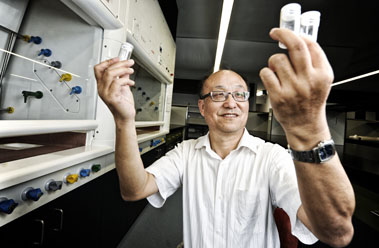Home > Press > Technology makes storing radioactive waste safer
 |
| Professor Huai-Yong Zhu from QUT Chemistry |
Abstract:
Queensland University of Technology (QUT) researchers have developed new technology capable of removing radioactive material from contaminated water and aiding clean-up efforts following nuclear disasters.
Technology makes storing radioactive waste safer
Brisbane, Australia | Posted on November 2nd, 2011The innovation could also solve the problem of how to clean up millions of tonnes of water contaminated by dangerous radioactive material and safely store the concentrated waste.
Professor Huai-Yong Zhu from QUT Chemistry said the world-first intelligent absorbent, which uses titanate nanofibre and nanotube technology, differed from current clean-up methods, such as layered clays and zeolites, because it could efficiently lock in deadly radioactive material from contaminated water.
The used absorbents can then be safely disposed without the risk of leakage, even if the material became wet.
"One gram of the nanofibres can effectively purify at least one tonne of polluted water," Professor Zhu said.
"This saves large amounts of dangerous water needing to be stored somewhere and also prevents the risk of contaminated products leaking into the soil."
RELATED ARTICLES
Safe storage for nuclear waste discovered
Air-purifying church windows early nanotechnology
QUT scientists on the way to sifting out a cure for HIV
The technology, which was developed in collaboration with the Australian Nuclear Science and Technology Organisation (ANSTO) and Pennsylvania State University in America, works by running the contaminated water through the fine nanotubes and fibres, which trap the radioactive Cesium (Cs+) ions through a structural change.
"Every year we hear of at least one nuclear accident. Not only is there a risk of contamination where human error is concerned, but there is also a risk from natural disasters such as what we saw in Japan this year," he said.
Professor Zhu and his research team believed the technology would also benefit industries as diverse as mining and medicine.
By adding silver oxide nanocrystals to the outer surface, the nanostructures are able to capture and immobilise radioactive iodine (I-) ions used in treatments for thyroid cancer, in probes and markers for medical diagnosis, as well as found in leaks of nuclear accidents.
"It is our view that just taking the radioactive material in the adsorbents isn't good enough. We should make it safe before disposing it," he said.
"The same goes for Australian sites where we mine nuclear products. We need a solution before we have a problem, rather than looking for fixes when it could be too late."
With a growing need to find alternatives to meet global energy needs, Professor Zhu said now was the time to put safeguards in place.
"In France, 75 per cent of electricity is produced by nuclear power and in Belgium, which has a population of 10 million people there are six nuclear power stations," he said.
"Even if we decide that nuclear energy is not the way we want to go, we will still need to clean-up what's been produced so far and store it safely," he said.
"Australia is one of the largest producers of titania that are the raw materials used for fabricating the absorbents of titanate nanofibres and nanotubes. Now with the knowledge to produce the adsorbents, we have the technology to do the cleaning up for the world."
####
For more information, please click here
Contacts:
Alita Pashley
QUT media officer
+61 07 3138 1841
Copyright © Queensland University of Technology (QUT)
If you have a comment, please Contact us.Issuers of news releases, not 7th Wave, Inc. or Nanotechnology Now, are solely responsible for the accuracy of the content.
| Related News Press |
News and information
![]() Researchers develop molecular qubits that communicate at telecom frequencies October 3rd, 2025
Researchers develop molecular qubits that communicate at telecom frequencies October 3rd, 2025
![]() Next-generation quantum communication October 3rd, 2025
Next-generation quantum communication October 3rd, 2025
![]() "Nanoreactor" cage uses visible light for catalytic and ultra-selective cross-cycloadditions October 3rd, 2025
"Nanoreactor" cage uses visible light for catalytic and ultra-selective cross-cycloadditions October 3rd, 2025
Discoveries
![]() Researchers develop molecular qubits that communicate at telecom frequencies October 3rd, 2025
Researchers develop molecular qubits that communicate at telecom frequencies October 3rd, 2025
![]() Next-generation quantum communication October 3rd, 2025
Next-generation quantum communication October 3rd, 2025
![]() "Nanoreactor" cage uses visible light for catalytic and ultra-selective cross-cycloadditions October 3rd, 2025
"Nanoreactor" cage uses visible light for catalytic and ultra-selective cross-cycloadditions October 3rd, 2025
Announcements
![]() Rice membrane extracts lithium from brines with greater speed, less waste October 3rd, 2025
Rice membrane extracts lithium from brines with greater speed, less waste October 3rd, 2025
![]() Researchers develop molecular qubits that communicate at telecom frequencies October 3rd, 2025
Researchers develop molecular qubits that communicate at telecom frequencies October 3rd, 2025
![]() Next-generation quantum communication October 3rd, 2025
Next-generation quantum communication October 3rd, 2025
![]() "Nanoreactor" cage uses visible light for catalytic and ultra-selective cross-cycloadditions October 3rd, 2025
"Nanoreactor" cage uses visible light for catalytic and ultra-selective cross-cycloadditions October 3rd, 2025
Environment
![]() Researchers unveil a groundbreaking clay-based solution to capture carbon dioxide and combat climate change June 6th, 2025
Researchers unveil a groundbreaking clay-based solution to capture carbon dioxide and combat climate change June 6th, 2025
![]() Onion-like nanoparticles found in aircraft exhaust May 14th, 2025
Onion-like nanoparticles found in aircraft exhaust May 14th, 2025
![]() SMART researchers pioneer first-of-its-kind nanosensor for real-time iron detection in plants February 28th, 2025
SMART researchers pioneer first-of-its-kind nanosensor for real-time iron detection in plants February 28th, 2025
Water
![]() Taking salt out of the water equation October 7th, 2022
Taking salt out of the water equation October 7th, 2022
|
|
||
|
|
||
| The latest news from around the world, FREE | ||
|
|
||
|
|
||
| Premium Products | ||
|
|
||
|
Only the news you want to read!
Learn More |
||
|
|
||
|
Full-service, expert consulting
Learn More |
||
|
|
||








